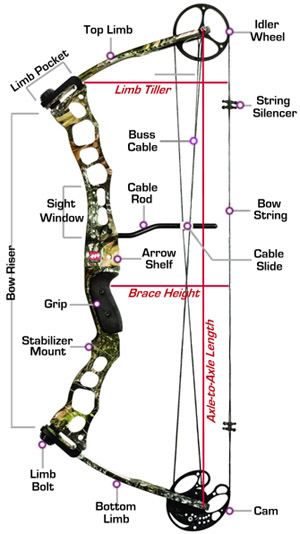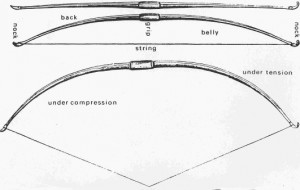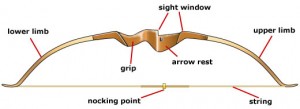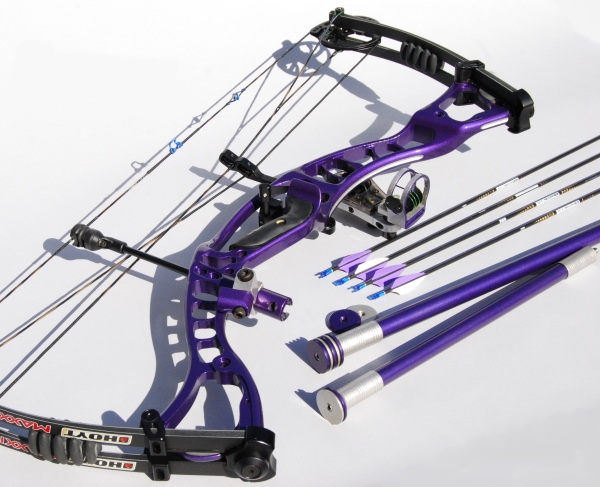There are many different types of Archery, and this page describes the different types that we shoot at this club.
Longbow
In various forms, are among the oldest styles of bows known to man. They are more truly in the category of “straight” bows, descending from their shorter ancestors used by early man and still prevalent in many tribal civilisations.
Straight bows grew longer and more powerful in the need to reach farther and hit harder as it became more of a weapon than a tool for hunting. The English longbow is perhaps the culmination of this type of bow. Its mark in history places it at the highest rank of respect in the world of archery.
The Medieval English longbow was a superb weapon, and used most effectively by the English from the end of the thirteenth century to the beginning of the sixteenth, many battles being won on its deadliness. It was particularly decisive in the battles at Crécy and Agincourt against the French. Its long range and armour piercing qualities made it a formidable weapon.
Traditional style longbows are difficult and time consuming to master, but have their benefits. Modern longbows utilise advances in design that make them more efficient with greater speed and accuracy. Many people have turned back to longbows because of their inherent “pointability” and instinctive accuracy. The lack of a “cutout” shelf is less distracting to the vision and helps bring the shooters focus to the mark, thereby reducing the time between target acquisition and release to a scant few seconds.
The English longbow can be made from several different types of wood. It can be crafted from either a single piece of wood (self bow) or from a mixture of different woods glued together to form a laminate.
Recurve (Olympic or Take-Down bow)
Target archery bow.
The recurve bow, as we know it, traces its ancestry to the Mediterranean region – Turkey in particular. The Turks were among the first to put a double bend in their bows, although this design could also be found in ancient Japan and other Asiatic countries. The recurve design is a stroke of genius for the age of its conception – some thousands of years BC. The “recurve” is simply refers to the shape and the way the limbs are constructed.
Building the limbs pre-curved at rest (hence, “pre-stressed”), the energy is gained rather than lost when drawn. This enables a bow to be compact, but with very great power. Recurve bows typically give greater arrow speed than longbows of equal strength.
A modern Recurve bow provides the shooter with more easily attainable accuracy and is therefore a good choice for both beginners and experienced archers’.
Other equipment can be added to the bow to help improve shooting accuracy, such as sights, stabilisers and clickers.
Compound
 The Compound bow was invented in 1967 by Holless Wilber Allen, from Missouri, USA. Originally developed for hunting, Allen spent six years developing this revolutionary bow. The compound bow relies on a range of cams and pulleys positioned at both ends of the limbs to provide its unique characteristics. Basically, as the bow is drawn to its full extent the “draw” weight is absorbed by this system of cams and pulleys. This means that at full draw the archer is required to hold significantly less weight on their draw arm, obviously allowing for a much more comfortable and controlled aiming. It also helps to offset the effects of fatigue, especially when a large number of arrows are being shot.
The Compound bow was invented in 1967 by Holless Wilber Allen, from Missouri, USA. Originally developed for hunting, Allen spent six years developing this revolutionary bow. The compound bow relies on a range of cams and pulleys positioned at both ends of the limbs to provide its unique characteristics. Basically, as the bow is drawn to its full extent the “draw” weight is absorbed by this system of cams and pulleys. This means that at full draw the archer is required to hold significantly less weight on their draw arm, obviously allowing for a much more comfortable and controlled aiming. It also helps to offset the effects of fatigue, especially when a large number of arrows are being shot.
Similarly with the Recurve bow sights and Stabilisers are usually added to the Compound bow in order to improve accuracy. Also a special release aid “trigger” is normally used to release the string when shooting the bow.






